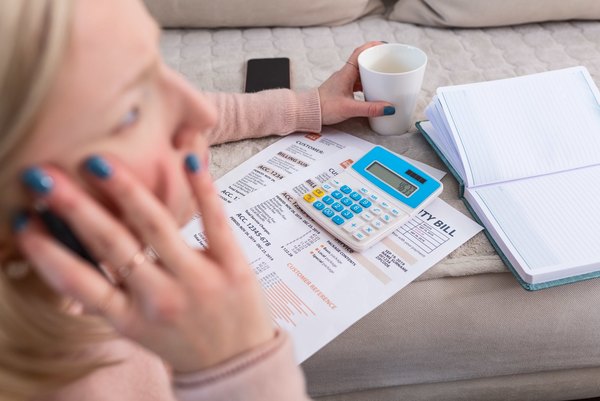If you're over your head in credit card debt, it's easy to feel as if you are drowning, and there's no way out. Fortunately, there are ways to get out of debt without letting it ruin your life.
Being in debt can be an overwhelming feeling, but with a little planning and discipline, you can use these easy-to-understand methods to eliminate your credit card debt once and for all.
Where Should You Start?
The first step of any process can be the most difficult, and beginning the slow climb out of debt is no exception. Staring at a mountain of debt can feel insurmountable. But every journey begins with a step!
Stop Using Your Credit Cards
It may seem obvious, but this step is crucial to take before you start any planning. You can't get out of credit card debt until you stop using your credit cards. Lock them up in a safe or give them to a trusted relative if you will be too tempted to use them. You must take this step before moving on.
Make a List of Your Debts
An essential step to tackling any problem is knowing its scope. Though it may seem like a painful step, it can, on some level, be liberating to capture the worries floating around in your head on paper.
Write each debt down on a separate piece of paper or sticky note: the total amount of debt carried on each card or loan, its APR, and the minimum monthly payment. Arrange all these sticky notes on your refrigerator or another visible place, so you can't avoid them.
You'll use this list to create your plan.
Prioritize Your Debts
Now it's time to plan. Choose a card to focus on paying down first. It can be the card with the lowest balance, highest balance, or the card with the highest APR. You choose what bothers you the most. Move this debt to the top of your list, separated visibly from the rest.
Ideally, you'll keep making minimum payments on all your cards, but this debt will be the focus of your efforts to make some headway.
In choosing this debt, there are a few routes you can take. Some people are motivated by little successes – choosing the smallest balance may motivate them to feel like they are making progress – while others might prefer to get the most expensive debt paid down first, even if it's the largest.
Decide How Much You Can Pay
Look closely at your budget. How much money do you have to pay toward your credit cards? You'll need to pay the minimum balance of every card, with any extra money paid toward the card you chose as the priority.
Keep the Cycle Going
Keep the balance amounts updated as you receive your statements, and continue focusing on the prioritized credit card until you pay it off in full. Then take that amount plus the minimum payment on the next card in line and pay that balance down. Keep the cycle going until you pay all of your credit card debt off.
Lifestyle Strategies You Need When Dealing with Debt
While you pay down your credit card debt, it's important to focus on your lifestyle. Ask yourself what got you into the situation in the first place. Where did you spend your money?
Of course, each person will have a different area that they can reduce their spending. Here's where a good budgeting app can make things easier to analyze by category, merchant, and month. Identify ways you can save going forward – this will not only help you avoid getting back into debt but make the climb out much more manageable.
Alternative Options When You Have No Choice
Sometimes, we get so far in over our heads that getting out of debt ourselves isn't achievable. When that happens, it may be time for more drastic measures:
Debt Consolidation
If you are a homeowner who has built up equity in your home, you may be able to use it to pay off your credit card debt through a cash-out refinance, home equity line of credit, or home equity loan. The rate you'll pay on these options is likely less expensive than what you're paying your credit card. Consolidating the debt puts it all in one place: you'll have one payment and one interest rate, which is typically lower than any credit card interest rate.
Debt Restructuring
If you don't have equity in your home or don't qualify for a home equity loan, you may need to restructure your debt. With this method, you work with a credit counselor that will restructure or negotiate your debts for you. Together you figure out how much you can pay each month toward the debt. You then make one payment, which gets distributed according to your chosen plan.
Because you aren't paying your debt as agreed, debt restructuring can damage your credit score significantly. It usually takes 3 – 5 years for your credit score to increase after satisfying your debts in a debt-restructuring plan.
Personal Bankruptcy
As a last resort, you may need to file bankruptcy. There are two types – Chapter 7 and Chapter 13. Chapter 7 dismisses your outstanding debts after liquidating any assets you have to pay the creditors. Chapter 13 bankruptcy sets up a repayment plan which you pay monthly. You have an assigned trustee that oversees your account and ensures that all creditors receive payments.
Because you don't repay the debt in a Chapter 7 bankruptcy, it can damage your credit score quite a bit. It will also stay on your credit report for ten years. While it won't affect your credit score for that long, it's still there for future creditors to see and will make things like getting a credit card nearly impossible.
A Chapter 13 bankruptcy falls off your credit report seven years after the filing date. Because you paid the debts in this plan, it doesn't damage your credit score as much, but your score may still fall. Future lenders will look at Chapter 13 bankruptcy more favorably because you still made good on your debts.
Break It Down, Stay Focused
Dealing with debt can seem overwhelming, but there are solutions. Take your time and break things down. Focusing on one debt at a time can help you get the process going. While you won't get out of debt overnight, with consistent effort, you can get yourself out of the feeling of drowning in debt.






